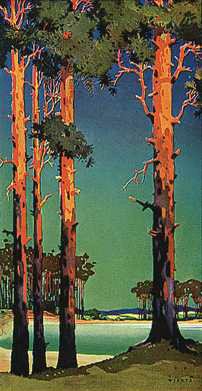
 |
| John & Valerie, Sandwich County Fair, Illinois, 1959 |
Pines whisper, then crescendo to a resonant hiss, then fall back with a hush, over and over, like a soft tide breaking on the sand, waves slowly washing back and forth. The long, stiff fronds of palms create a dry, grassy sound, like glazed paper wind chimes. Cypress are almost silent; their tiny, soft leaves make as little noise as an owl's downy feathers. Trees in a rain forest probably have their own conversations, but who could hear it over the cacophony of the myriad insects, monkeys, and birds, not to mention the sound of incessantly dripping water? Oaks rustle, and their acorns make a satisfying "plop" as they fall on the moss below. The noisiest trees are aspens, with their round, clattery leaves, fueled by high mountain breezes.
cacophony of the myriad insects, monkeys, and birds, not to mention the sound of incessantly dripping water? Oaks rustle, and their acorns make a satisfying "plop" as they fall on the moss below. The noisiest trees are aspens, with their round, clattery leaves, fueled by high mountain breezes.
When leaves have fallen for the year, but before the snow muffles all sounds, the branches have their say. There are small cracklings, then clicks and groans. As the wind picks up, the swaying follows a complex rhythm of whines and thumps and moans, until the wood cries out as if it is about to break.
And, by the way, if a tree falls in the forest and nobody is there, it does indeed make a splendid noise, because it doesn't need anything as insignificant as a pair of human ears to validate its existence or dramatic action.
But trees allow us to listen. If a person is very quiet, and attentive, in the warm stillness of a summer afternoon, she can even hear the trees grow.